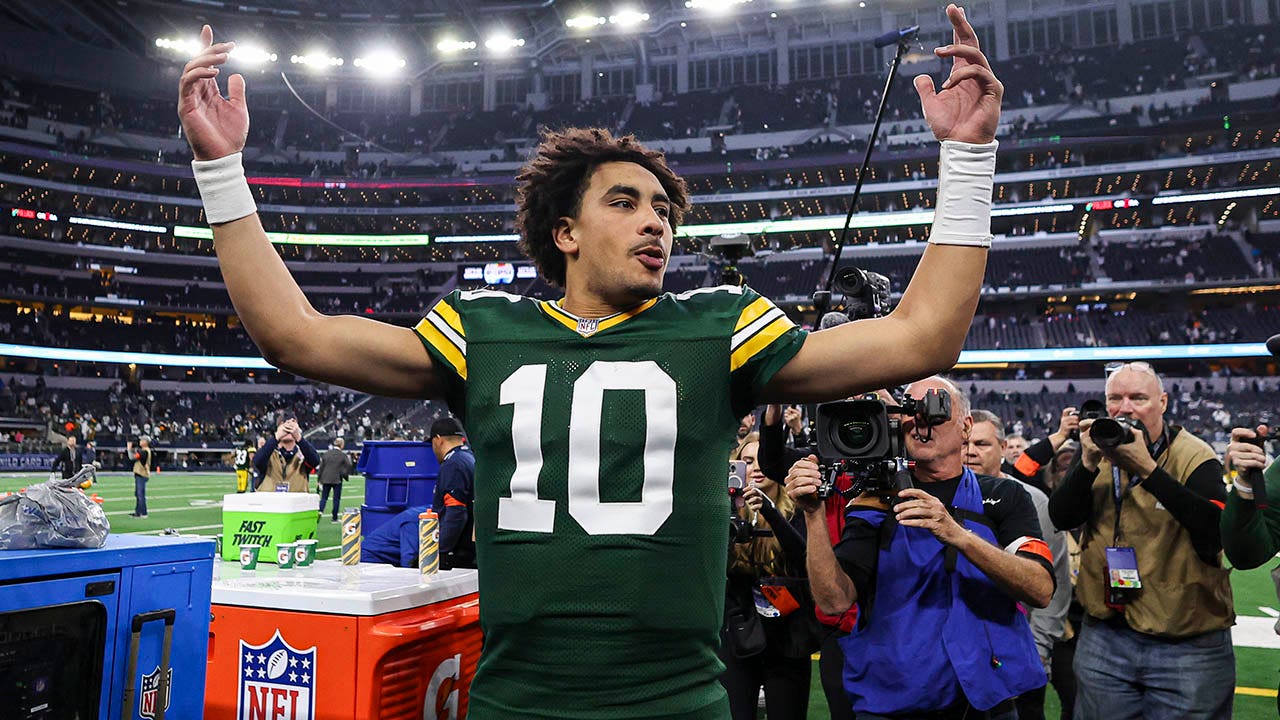Throw in the writers and actors strikes — work stoppages that struck at the creative heart of an industry that prides itself on compelling narratives and charismatic mammals known as “stars” — and add a persistent covid-era decline in theatrical attendance, and you get a movie culture with a severe case of the jitters. While Disney and Warner Bros. Discovery sought to bring up the bottom line by canceling projects and shelving finished films (R.I.P. “Coyote vs. Acme”), Paramount was not so quietly hanging out the for-sale sign, in the hopes of staying in a game that is feeling more Darwinian with every quarterly report.
And yet, one of the most unpredictable years in movie history has somehow yielded an exceptionally predictable Academy Awards season. Prognosticators aren’t expecting many surprises at the ceremony March 10, save for the precise number of awards “Oppenheimer” will take home. But that sense of micro-certainty doesn’t translate to anything bigger, permanent or more assured where the art form and industry are concerned.
The nobody-knows-anything-ness of the current moment carries particular potency for me this year: Not long after the final acceptance speech has ended in happy tears, I will be taking a year off to work on a book and occasional reporting projects. I won’t be covering Oscar season again until 2026, a prospect as rife with tantalizing possibility as with Pavlovian pessimism. Will superhero fatigue finally prove fatal to the genre that has monopolized the attention economy for two decades? Will the streaming spigot slow to a trickle, forcing auteurs to find new homes for their pricey passion projects? Will Quentin Tarantino have retired, only to be replaced by an AI avatar?
What will movies look like?
Because, let’s face it: They looked pretty terrific in 2023, even as anxieties and dire auguries piled up. But the movie industry is notorious for learning precisely the wrong lesson from its successes, not to mention failures. Here are some trends from last year that I hope to see more of by the time I return, as well as a few that, with luck, will fail to gain traction and instead skid into oblivion.
The best thing about Barbenheimer was that the year’s biggest financial successes weren’t sequels or reboots, but audaciously original one-offs. Yes, Christopher Nolan’s “Oppenheimer” was adapted from a best-selling book and Greta Gerwig based “Barbie” on an iconic toy. But both filmmakers took their source material in bold, utterly surprising directions, gambling that audiences would connect with their deeply personal and often idiosyncratic visions.
Nolan and Gerwig weren’t the only filmmakers who swung for the fences in 2023: Bradley Cooper created a kaleidoscopic portrait of Leonard Bernstein in “Maestro”; Yorgos Lanthimos and Emma Stone went for broke (and, frankly, went a little bonkers) in “Poor Things”; Kristoffer Borgli let Nicolas Cage go zanily normcore in the giddily reality-adjacent “Dream Scenario”; and Ava DuVernay invented a new, structurally complex form of documentary and narrative in “Origin,” which left audiences stunned not just by its intellectual inquiry into the structures of oppression but by its raw emotional power. These movies proved that there’s still room in cinema for ambition, imagination and recklessly piratical risk-taking.
But don’t forget to strengthen the middle class!
This year’s crop of Oscar hopefuls spans an Imax extravaganza such as “Oppenheimer” to the demanding, aesthetically rigorous Holocaust drama “The Zone of Interest.” In between can be found such gems as “American Fiction,” “The Holdovers” and “Anatomy of a Fall,” movies whose smart, accessible storylines and polished production values hark back to when a good movie was good enough. (Remember 2022, when our holiday viewing choices were a man throwing his severed fingers at his friend’s door and another man eating himself to death? Oh, what a difference a year makes.)
People who saw this year’s nominees were treated to a wonderfully diverse array to choose from. But too many worthy but under-resourced films didn’t find the audience they deserved. The same wealth inequality that plagues American society can be seen in Hollywood, where the big get richer and the middle class is routinely squeezed or forgotten entirely. Consider: Of the 10 best-picture nominees, “Barbie” and “Oppenheimer” might have earned more than $2 billion between them, but only two of their competitors (“Killers of the Flower Moon” and “Poor Things”) have cleared $100 million at the box office.
Even with these disparities, viewers in 2023 proved they will leave home and show up for movies that aren’t supersize spectacles: They enthusiastically showed up for “Air,” Ben Affleck’s hugely appealing story of the invention of an iconic basketball sneaker. They made a runaway hit out of “Anyone but You,” an otherwise bland rom-com elevated by its easygoing, preternaturally attractive stars. Older audiences looking for family-friendly uplift during the December holidays found it in George Clooney’s underdog sports drama “The Boys in the Boat.” Last year’s biggest non- Barbenheimer story was the sleeper-phenom (and controversy magnet) of the summer, “The Sound of Freedom,” about the scourge of human trafficking.
Those movies are all dramatically different in form, content and quality (“Anyone but You” was so formulaic, it might as well have been created by ChatGPT). But they have one thing in common: They all knew who their core audiences were, and they knew how to find them — whether by way of viral social media campaigns, grass-roots outreach or old-fashioned good timing.
We already have two examples of that kind of connection in 2024: Both “Perfect Days,” Wim Wenders’s entrancing (and Oscar-nominated) portrait of a Tokyo restroom-cleaner, and “Bob Marley: One Love,” in which Kingsley Ben-Adir stars as the titular reggae star, have over-performed with audiences, suggesting that the assumption that only Spandex, horror and cartoons can lure audiences into theaters is overdue for a refresh.
Escapism doesn’t have to be dumb; it doesn’t even have to be escapist
In recent years, the Oscars have rewarded the small, the quirky and, sometimes, the downright weird. No sooner was Guillermo del Toro speculating on a love affair between a woman and a fish in 2018 best-picture winner “The Shape of Water” than Jamie Lee Curtis and Michelle Yeoh were having way too much fun with hot-dog fingers in last year’s big winner “Everything Everywhere All at Once.”
If “Oppenheimer” takes top honors Sunday, as is generally presumed, it will be the most widely seen movie to win best picture since the days of “Titanic” and “The Lord of the Rings” — a return, of sorts, to the kind of big, boffo blockbusters that Hollywood has always excelled at but only occasionally seen as Art-with-a-capital-A.
In fact, this year’s slate of Oscar-worthies demonstrates how audience-friendly movies don’t have to sacrifice meaning on the altar of pleasing the crowd. Gerwig and her co-writer, Noah Baumbach, didn’t sneak a feminist message into “Barbie” as much as wrap a big pink bow around a cheerful anti-patriarchal polemic; “American Fiction” served up barbed satire about racism and White liberal hypocrisy alongside generous-hearted family drama and tender romance; “The Holdovers” was a comforting throwback to the 1970s and that era’s winsome humanism but managed to make timely points about entitlement and unexamined privilege.
In other news, the underperformance of lazy franchise extenders such as “The Marvels,” “Ant-Man and the Wasp: Quantumania” and the recent “Madame Web” indicated that viewers will no longer tolerate flimsy cash grabs masquerading as fan service.
Heaven knows we’ve needed escapism these past few years. And I suspect we’ll still need it in 2026. But I want dream worlds that aren’t devoid of substance, just like I want substance that isn’t always delivered by way of dour realism. Movies can be just as deep when they’re delightful.
Not long I ago, I called for a return to the good, old-fashioned sex scene. Plenty of writers and directors have apparently been feeling the same way, creating films that acknowledged the realities of physical intimacy with frankness and lush sensuality. My favorites, Ira Sachs’s “Passages” and Andrew Haigh’s “All of Us Strangers,” introduced refreshing candor to the depiction of gay men’s love lives, after years of carnal pleasure being primly airbrushed out of dramas such as “Brokeback Mountain” and “Milk.” Viewers argued about Cillian Murphy’s J. Robert Oppenheimer reciting the Bhagavad Gita — from the original Sanskrit! — to Florence Pugh’s Jean Tatlock while in the throes of passion (the scene came in for outraged criticism in India). But I welcomed the idea that sex and intellect aren’t mutually exclusive and indeed are deeply interwoven.
We’ve had our share of titillation, too: Emma Stone’s child-woman character in “Poor Things” “furious jumping” from bed to bed in a lusty journey of self-discovery feels simultaneously liberated and creepily voyeuristic; the lesbian sexuality at the center of “Drive-Away Dolls” and “Love Lies Bleeding” owes as much to raunchy B-movie pulp as to recognizable real life. Barry Keoghan’s pathologically seductive antihero in “Saltburn” was so pansexual that he even got it on with a tub of cold bathwater (unleash the memes!). Shock appeal will always have its place, but let’s hope more filmmakers explore the fruitful middle ground between puritanism and prurience, and find new ways to infuse their films with the expressiveness, honesty and joy of sex.
Young people might be saving theaters
It wasn’t surprising when hordes of pink-clad and friendship-braceleted kids flooded theaters for repeat viewings of “Barbie” and “Taylor Swift: The Eras Tour.” But few expected teenagers to flock to “Oppenheimer” — perhaps because of all the Barbenheimer hype, but not incidentally because they found the movie to be such a compelling, immersive experience that they just had to see it in Imax. (“Dune: Part Two” is benefiting from the same event-izing.) Contrary to conventional wisdom about kids’ waning attention spans, Nolan’s three-hour epic turned out to fit right in with Gen Z’s always-scrolling viewing habits.
Even more surprising, young people seem to be driving at least some of the recent success of “Perfect Days,” which (checks notes) is about a man cleaning toilets. Between #Filmtok and Letterboxd, it looks like a new generation of discerning film fans might be incubating before our eyes, thanks to the very technology that was supposed to kill cinema.
And the youngs aren’t just showing up for new releases; they’re also sampling classics at their local independent theaters, shoring up the foreign-film and repertory programs that are keeping many of those places afloat. Which aptly sums up my fondest wishes for 2026: that we’ll still have a steady stream of variegated, well-conceived and adroitly executed movies to see, and that there will be audiences ready to embrace them. For now: See you on the other side.















































